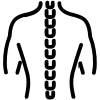Sitting all day at a desk can be disastrous for your health. These days, ergonomic furniture has come to the rescue, with options like ball seats and standing desks helping office workers take greater control over their well-being. An even more active solution to desk-job woes, however, is the walking pad. These small treadmills are becoming increasingly popular, and they allow users to walk as they work*—*reaping all the benefits of exercise while sending off the day’s emails.
The Dangers of Physical Inactivity at Work
Most people who work desk jobs move very little during the day. This lack of physical activity comes with numerous risks for your physical health, mental health, and productivity. According to the World Health Organization, physical inactivity is at the root of 3.2 to 5 million deaths every year.
Back Problems and Musculoskeletal Disorders

Spending hours sitting every day makes you more likely to deal with poor posture, muscle tension, stiffness, and back pain.
Musculoskeletal disorders (MSDs)—and the chronic pain and fatigue that come with them—are a common reason that employees have to take sick leave.
Cardiovascular Health
Physical inactivity lowers your heart rate and slows your circulation. This circulatory slugglishness makes it easier for cholesterol and fat deposits to build up in your arteries, increasing your risk of cardiovascular disorders like hypertension and atherosclerosis.
Diabetes

A lack of physical activity can also slow down your metabolism. It affects how your body regulates blood glucose regulation, causing you to become insulin resistant. In the long term, that resistance can lead to Type 2 diabetes—a major health problem in many developed countries.
Blood Circulation
Physical inactivity is at the root of circulatory problems like veinous stasis. Heavy legs, swelling, edemas, and even phlebitis are some of the possible consequences of poor circulation.
Mental Health
Beyond its consequences for your body, physical inactivity negatively impacts your mental health. It increases stress, anxiety, and mental fatigue, all of which can lead to depression. A lack of physical activity causes your body to release more of the “stress hormone,” cortisol, and less of the “feel-good hormones,” endorphins.
The Benefits of Walking While Working
Walking as you work, even at low speeds, is a highly effective way to get in more activity during the day and decrease your risk of the health complications associated with a lack of movement. Here are some of the ways that workday walking gives your well-being a boost:
Posture and Pain Prevention
Walking as you work prevents back pain by improving your posture. A more upright position reduces pressure on your back and neck. Walking also activates your muscles, releasing muscle tension and helping prevent musculoskeletal disorders.
Better Performance

Walking as you work stimulates your circulation and increases the flow of oxygen to your brain. The result? Higher productivity and greater motivation. Your awareness and focus increase, too, making you more efficient at your work and less prone to making mistakes. A slow walk can also boost your creativity. A study by the University of Stanford found that walking on a treadmill helps get ideas flowing.
Less Stress, More Energy
Walking triggers the release of endorphins in your body. These “feel-good hormones” reduce stress, anxiety, and even your perception of pain. Your energy, motivation, mood, and mental health all get a major lift.
Weight Management

Finally, walking slowly while you work raises your metabolism and makes it easier for you to maintain a healthy weight, especially if you’re also eating a balanced diet.
You burn more calories than you do when sitting, which helps give you an edge over the weight gain often associated with sedentary work.
Read our full article on 12 Tips for Losing Weight at Work.
Walking Pad: A Perfect Way to Stay Active on the Job

You have to plan your schedule around a workout, but a walking pad lets you easily add exercise into your day as you go about your other responsibilities. This alternative to standing desks and ball seats lets you sprinkle light physical activity into your routine—helping you stay active and improve your quality of working life (QWL) while still getting your work done.
Pros of Walking Pads
Walking pads can:
- Reduce the time you spend sitting down
- Improve your physical condition
- Reduce stress
- Stimulate your focus and creativity
- Relieve pain and musculoskeletal disorders
They also tend to be easy to install in just about any workspace, depending on the model.
Cons of Walking Pads
However, walking pads aren’t practical for every kind of activity nor for every kind of person. For example, people whose jobs require precise drawing or a significant amount of writing may find it difficult to work well while walking. Moreover, certain models can be bulky or noisy. The sound that louder pads emit can disrupt the user’s focus. Finally, they are not compatible with most desks. Walking pads can only be used with desks whose height can be adjusted, like standing desks.
How to Use a Walking Pad
Choosing a Walking Pad
You can find many different models of walking pads online. Their prices can range from around one hundred dollars all the way up to one thousand. It’s best to choose a model that is compact and quiet. Above all, make sure that it fits your standing desk or can be adjusted to fit it.
How Fast Should You Walk?
It’s best to walk at a speed between 0.5 and 2.5 mph so that you can still work on your computer. Test different speeds to see which one works best for you.
We suggest starting:
- With short sessions of 10 to 15 minutes a day, increasing the minutes over time.
- At a speed between 1 and 1.5 mph to prevent fatigue as your body adjusts.
Once you’ve gotten used to this way of working, you can walk around 30 to 60 minutes a day, alternating your walking pad with an active chair or with standing.
Best Practices
Make sure that your walking pad and your desk are at an ergonomic height. Sit with:
- A straight posture, to prevent pain and muscle tension
- Your elbows at a 90° angle
- Your shoulders relaxed
- Your screen at eye level to prevent neck pain and eye strain
We also recommend changing positions regularly (sitting, walking, standing), wearing good walking shoes, staying hydrated, and taking regular breaks to stretch.
FAQ: Walking While Working
Is It Better to Work Sitting Down or Standing Up?
There’s not one perfect position—rather, remaining too long in any one position can have negative effects on your health. The key is to alternate between sitting and standing, and walking provides all of the benefits of standing while adding in physical activity.
Will Walking While I Work Help Me Lose Weight?
Walking as you work can help prevent weight gain by burning a moderate amount of calories .
When combined with a healthy lifestyle, and especially with a balanced diet, walking at your desk can contribute to weight loss.
Is it Legal to Work Standing or Walking?
Yes! There is no law against standing or walking as you work. On the contrary, legislation encourages employers to provide their employees with safe, ergonomic working conditions.
Can I Really Work on a Walking Pad?
Yes, you can work on a walking pad. It’s helpful to buy a quiet model that won’t distract you, and make sure that it’s at the right height for your work desk. Walk at a pace that allows you to complete the tasks you need to.
Keep in mind that you can’t do every task while on a walking pad. Emails, phone calls, and even some video calls are perfectly fine, but tasks that require a significant amount of thinking and reflection are often best performed either sitting or standing.
Can I Use a Walking Pad With Any Kind of Desk?
Using a walking pad requires being upright, which means that you’ll need a desk whose height you can adjust—for example, a standing desk. They cannot be used, however, with a classic desk.
Conclusion
Walking pads aren’t just fancy gadgets—they’re a powerful potential ally in your fight against a sedentary lifestyle. Walking at a slow pace as you work has incredible benefits for your physical and mental health. It doesn’t make you any less productive, and it can even improve your productivity and focus. If you’re planning on trying out a walking pad, make sure to choose one that fits your desk correctly, alternate between walking and sitting or standing throughout the day, walk with correct posture, and choose a pace that allows you to still perform your work duties.











